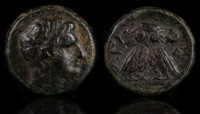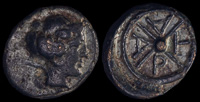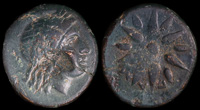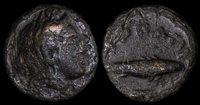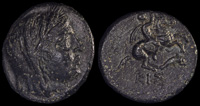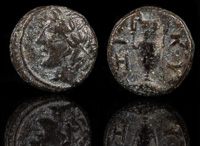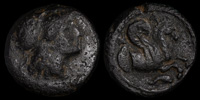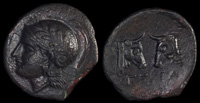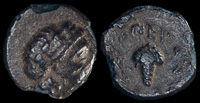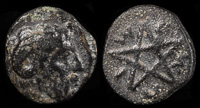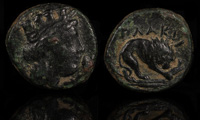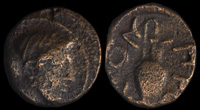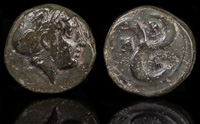Mysia
Pitane is founded by colonists from Lesbos.
Prokonnesos is founded by settlers from Miletos.
Apollonia ad Rhyndakum is founded by settlers from Miletos.
With the downfall of the Kingdom of Lydia, Adramytteion, Parion, Phokaia, and Aigai go under the Persian Empire.
During the Ionian revolt (year approximate), Artake and Prokonnesos are burned by the Persians.
Artake first appears in tribute lists of the Delian League.
The satrap of Phrygia, Pharnakes, offers asylum in Adramytteion to exiles from Delos.
Prokonnesos is conquered for Athens by Alkibiades.
Lysander destroys the Athenian fleet at the mouth of the Aigiospotamoi. Just before, the Athenian triremes arrive at Elaios to discover that Lysander is in control of Lampsakos.
Peloponnesian War ends in an Athenian surrender, and as a result Adramytteion is ruled by Mytilene. Residents of Aegina are allowed to return to their island.
The 10,000, as described in Xenophon’s Anabasis, travel through Antandros and Adramytteion.
397 BCE
March
Xenophon’s command of the 10,000 ends at Pergamon.
Peace of Antalkidas, arranged by Artaxerxes II, is signed in Susa, ending the Corinthian War. Abydos, Aigai, Kalchedon, Kaunos, Klazomenai, Kyzikos, Parion, Samos, and Adramytteion become part of the Persian Empire.
Estimated birth of Anaximenes in Lampsakos.
Autophradates besieged Ariobarzanes, who was participating in the Great Satraps Revolt, in Adramytteion.
Adramytteion abandoned with arrival of the Sparta king, Agesilaos II.
Orontas takes a leadership role in the Great Satraps Revolt. He then switches his allegiance to Artaxerxes II. He uses Pergamon as his base.
Orontas revolts again and takes Pergamon. He eventually reconciles with Artaxerxes III and ends the revolt.
Hermeios becomes tyrant of Atarneos.
Either Memnon of Rhodes or his brother Mentor capture Hermeios, tyrant of Atarneos, and put him to death.
Memnon of Rhodes is tasked by Darius III with taking Kyzikos and nearly does. It is defended by Kalas.
Abydos is besieged by Memnon of Rhodes, forcing Parmenion to give up his siege of Pitane.
Alexander the Great captures Kyzikos and commissions the effort to connect it to the mainland.
Anaximenes supposedly tricks Alexander III into not destroying Lampsakos.
Priapos surrenders to Panegoros, a general under Alexander III.
May
The Battle of the Granicus, during which Alexander the Great defeated the Persians under Darius III, and after which Adramytteion and Kaunos come under his control. Kalas participates with the Thessalian cavalry under Parmenion. Perdikkas serves on the right.
June 30
Partition of Babylon. Abydos and Adramytteion come under control of Leonnatos. Egypt with Alexandria and Gaza are under Ptolemy. Baktria comes under Seleukos I Nikator. Asandros obtains Caria. Laomedon receives Koele-Syria.
Adramytteion seized by Antigonos I Monophthalmos.
Arrhidaios, the governor of Hellespontine Phrygia, besieges Kyzikos, who are under Antigonos Monophthalmos.
Herakleitos of Pitane, son of Lysistratos, is honored for some reason in Delphi.
Adramytteion and Ephesos are taken by Prepalaos, a general under Lysimachos.
Lysimachos appoints Philetairos commander of Pergamon, including its vast treasury.
Demetrios Poliorketes ravages the territory of Lysimachos and takes Lampsakos twice without holding it.
Philetairos deserts Lysimachos and offers Pergamon to Seleukos I Nikator. This begins the Kingdom of Pergamon.
Lysimachos defeated at the Battle of Coropedion. Adramytteion, Ainos, and Abydos come under control of the Seleukid Empire. Ephesos returns to its original name.
Philetairos provides food and aid to Kyzikos against invading Gauls.
Eumenes I becomes ruler of the Kingdom of Pergamon after the death of Philetairos.
Antiochos I Soter is defeated while attempting to retake Pergamon by the Attalid Eumenes I in a battle near Sardis.
Attalos attacks the forces of the usurper Adaios and defeats him, then engages in friendly negotiations with Lampsakos, Alexandria Troas, and Ilion, all of which had remained loyal to him.
Construction of the Library of Pergamon begins.
Countryside around Adramytteion pillaged by Philip V of Macedon.
197 BCE
Antiochos III, desiring to meet Rome in battle, is detained by the cities of Alexandria Troas, Smyrna, and Lampsakos, which refused entreaties.
New city walls are constructed in Pergamon.
Priansos and other cities in Crete sign an alliance with Eumenes II of Pergamon.
The Pergamon Altar is constructed.
The Library at Pergamon reaches its peak form.
Adramytteion, Smyrna, Sestos, Synnada, Philadelphia, Laodikeia ad Lykon, Attalaia, Erythrai, Ephesos, Perge, Hierapolis, and Assos come under Roman control after Attalos III, the last Attalid king, leaves it to Rome in his will.
126 BCE
Manius Aquillius is governor of Asia and rebuilds the road from Adramytteion to Smyrna.
Mithridates VI makes Pergamon his headquarters of his war against Rome.
Sulla uses Kypsela as a base while Mithridates uses Pergamon, and between these places they meet.
Kyzikos is defended by the Romans against a siege by Mithridates VI.
Marc Antony seizes 200,000 scrolls from the Library at Pergamon and gifts them to Kleopatra for the Library at Alexandria.
Adramytteion, Aigai, Philadelphia, Apollonis, Hierapolis, Smyrna, Sardis and Magnesia are severely damaged by an earthquake. Tiberius provides financial support.
Per Acts 27:2, Adramytteion is the location where the Apostle Paul is transported as a prisoner.
Adramytteion severely damaged during an earthquake. Trajan provides funds to rebuild it.
The Emperor Hadrian founds Hadrianotherea to commemorate a successful hunt.
An earthquake destroys Kyzikos, including the newly built Temple to Hadrian. Funds for its rebuilding are allocated by Antoninus Pius.


